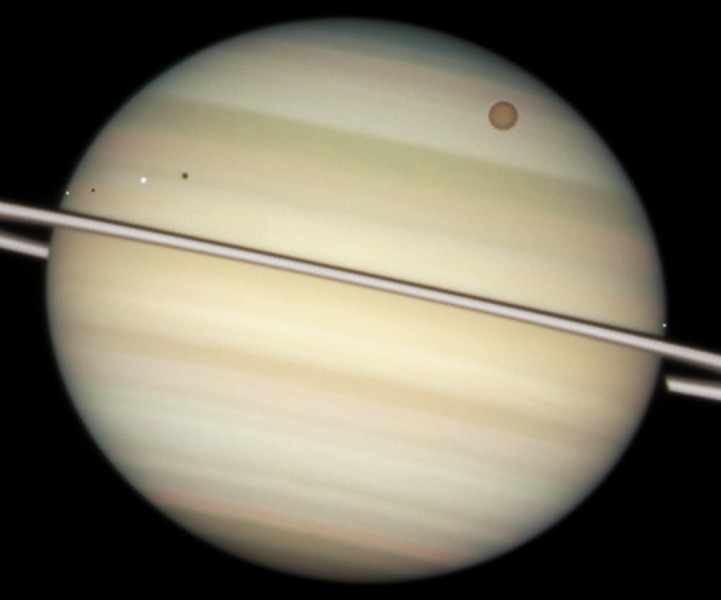
|
Credit & Copyright: NASA,
ESA,
Hubble Heritage Team
(STScI/AURA)
Acknowledgment: M.H. Wong (STScI/UC Berkeley), C. Go (Philippines)
Explanation:
Every 14 to 15 years, Saturn's rings
are tilted
edge-on to our line of sight.
As the bright, beautiful rings seem to grow narrower
it becomes increasingly
difficult to see them, even with large telescopes.
But it does provide the opportunity to watch multiple
transits of Saturn's moons.
During a transit, a sunlit moon and its shadow
glide across the cloudy face of the gas giant.
Recorded on February 24,
this
Hubble image is part of a
sequence
showing the transit of four of Saturn's moons.
From left to right are Enceladus
and shadow,
Dione
and shadow, and
Saturn's largest moon Titan.
Small moon Mimas is just
touching Saturn's disk near the
ring plane at the far right.
The shadows of Titan and Mimas have both moved off
the right side of the disk.
Saturn itself
has an equatorial diameter of about 120,000 kilometers.
Acknowledgment: M.H. Wong (STScI/UC Berkeley), C. Go (Philippines)
|
January February March April May June July August September October November December |
| |||||||||||||||||||||||||||||||||||||||||||||||||||||||
NASA Web Site Statements, Warnings, and Disclaimers
NASA Official: Jay Norris. Specific rights apply.
A service of: LHEA at NASA / GSFC
& Michigan Tech. U.
Based on Astronomy Picture
Of the Day
Publications with keywords: Saturn - transit - Saturn's Moon
Publications with words: Saturn - transit - Saturn's Moon
See also:
- APOD: 2025 September 25 Á Saturn Opposite the Sun
- APOD: 2025 September 22 Á Equinox at Saturn
- APOD: 2025 July 24 Á Titan Shadow Transit
- Stereo Helene
- APOD: 2025 March 16 Á Venus and the Triply Ultraviolet Sun
- APOD: 2025 February 23 Á Saturn in Infrared from Cassini
- APOD: 2024 December 8 Á Aurora around Saturns North Pole
